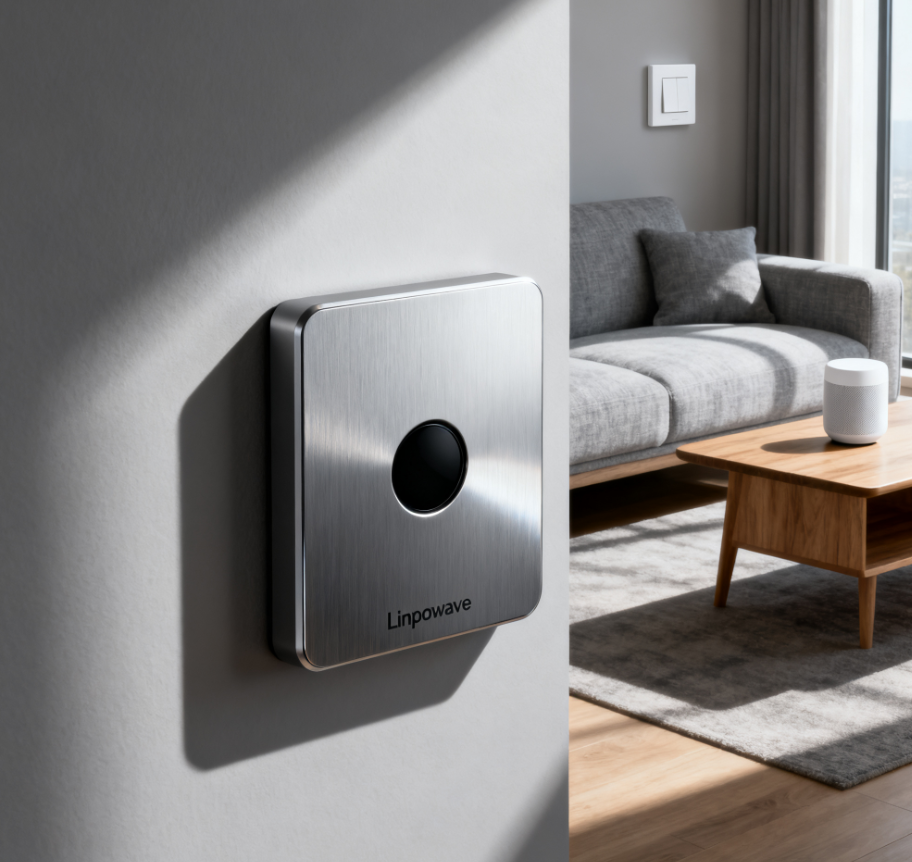Smart homes have transformed how we live, making lighting, climate, and security systems more connected and intelligent. Yet, despite years of innovation, many homeowners still struggle with one frustrating problem: smart switches that cannot reliably detect whether someone is in the room.
This pain point is common among enthusiasts who experiment with different devices. Traditional PIR (Passive Infrared) sensors often fail because they only detect motion, not presence. If you sit quietly while reading or working on a laptop, the lights may suddenly turn off, leaving you waving your arms to bring them back. And while cameras could solve this, most people do not want surveillance hardware watching them in their own homes.
This gap is exactly where mmWave radar technology shines. By integrating radar into wall switches, manufacturers and integrators can finally deliver on the promise of true, seamless presence detection.
Why Traditional PIR Sensors Fall Short
PIR sensors have long been the go-to solution for occupancy detection in smart lighting and automation systems. They work by sensing changes in infrared radiation caused by moving heat sources, such as a person walking across a room.
However, PIR has serious limitations:
-
Static presence blind spot: If a person remains still, PIR assumes the room is empty.
-
Narrow field of view: Coverage is limited and often misses areas outside the sensor’s cone.
-
Environmental interference: Sunlight, heating vents, or even pets can trigger false positives.
-
Inconvenience: Users often report lights turning off while they are still in the room, leading to frustration.
For modern smart homes that promise comfort and automation, this is a fundamental flaw. Homeowners need presence detection that “just works.”
How mmWave Radar Solves the Problem
Millimeter-wave (mmWave) radar takes a fundamentally different approach. Instead of relying on heat, mmWave emits high-frequency electromagnetic waves and analyzes their reflections. This allows it to detect even the smallest human movements, including breathing and subtle body shifts.
Key advantages of mmWave in smart switches include:
-
True presence detection: mmWave can sense occupants even when they are perfectly still.
-
High sensitivity: Detects micro-movements such as respiration or finger gestures.
-
Privacy-friendly: Unlike cameras, mmWave does not capture images or audio.
-
Compact form factor: Modules are small enough to be integrated into standard wall switch panels.
-
Resilience: Less affected by lighting conditions, temperature, or environmental noise.
According to the International Energy Agency (IEA), combining intelligent presence detection with automated lighting can reduce electricity consumption by 30–60% in residential and commercial buildings. This makes mmWave not only a comfort feature but also a powerful energy-saving tool.
Applications: From Lighting to Full-Scale Smart Living
When mmWave radar is built into smart switches, it transforms the role of these devices from simple controllers to intelligent presence hubs.
-
Lighting Automation
-
Lights turn on instantly when someone enters the room and remain on while occupants are present—even if they remain still.
-
Eliminates the annoyance of waving at the sensor to keep the lights on.
-
-
Climate and Ventilation Control
-
HVAC systems can adjust airflow or temperature based on the number of people present.
-
Prevents energy waste when rooms are unoccupied.
-
-
Energy Savings
-
Reduces unnecessary power consumption in empty spaces.
-
Supports sustainability goals in both residential and commercial buildings.
-
-
Smart Hospitality and Offices
-
In hotels, integrated radar-enabled switches create a luxurious “walk-in comfort” experience.
-
In office spaces, mmWave can optimize lighting and climate dynamically, improving employee comfort while lowering operational costs.
-
-
Enhanced Safety and Security
-
Radar-based detection can confirm occupancy without the invasiveness of cameras.
-
Useful for elder care and wellness monitoring, as mmWave can detect subtle vital signs like breathing.
-
Linpowave’s Role in Enabling Smart Switches
Linpowave specializes in compact, high-performance mmWave radar modules designed for integration into consumer and commercial devices. For smart switches, our modules offer:
-
Seamless integration into standard switch panels and wall-mounted devices.
-
Flexible connectivity, supporting platforms such as Home Assistant, KNX, and custom automation ecosystems.
-
Rich data output, including presence, motion intensity, and even estimated occupancy counts.
-
Low power consumption, optimized for continuous operation on mains power.
For system integrators, OEMs, and smart home solution providers, Linpowave modules provide the building blocks for creating next-generation smart switches that deliver reliable, privacy-first, and future-ready presence detection.
The Future: Smart Switches as the Brain of the Room
The evolution of smart switches is moving beyond manual control or simple automation. With mmWave radar, switches are becoming sensors, controllers, and intelligence nodes in one compact form factor.
In the near future, we can expect to see:
-
Widespread adoption of radar-enabled switches in premium smart homes and commercial spaces.
-
Fusion with other sensors such as temperature, CO₂, and light for all-in-one environmental monitoring.
-
Context-aware automation, where systems respond not only to presence but also to occupant behavior and comfort needs.
By embedding mmWave radar, smart switches finally live up to their name: smart, reliable, and truly adaptive.
FAQ
Q: What is the difference between mmWave radar and PIR sensors?
A: PIR sensors only detect motion, while mmWave radar can detect even static presence by recognizing micro-movements such as breathing.
Q: Can mmWave radar be integrated into wall switches?
A: Yes. Linpowave’s compact modules are designed for easy integration into standard switch panels and wall-mounted devices.
Q: Does mmWave pose privacy risks?
A: No. Unlike cameras, mmWave does not capture images or audio. It only detects presence and movement patterns.
Q: Can mmWave sensors work with existing smart home platforms?
A: Yes. Linpowave modules support integration with systems like KNX and Home Assistant, making them ideal for both residential and commercial automation.



